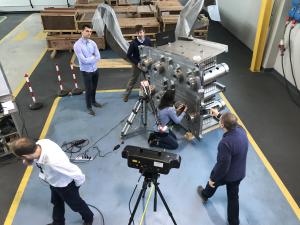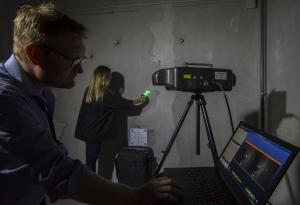Welded attachments
Follow the laser projections
4 Nov 2019
-
Guy Sandford, ITER construction engineer
How do you position 150,000 welded attachments on to a vacuum vessel the size of a house, each one needing to be accurately placed to less than a 4 mm target?
Laser templating is tested on a mockup of the ITER vacuum vessel at Walter Tosto in Chieti, Italy, by a team composed of ITER Organization and European Domestic Agency specialists. Not only will this innovative technique help assembly contractors place each of the vacuum vessel's 150,000 welded attachments precisely, but it will be key to producing unique identification numbers for quality control and inspection.
Traditional methods of marking and laying out—either by measuring from existing features, or using a template—do not work well on the ITER vacuum vessel; the complex curved shape and sheer quantity of attachments mean these old techniques are time-consuming and inherently inaccurate and error-prone.
After investigating several alternatives, a team composed of ITER and European Domestic Agency (Fusion for Energy) specialists evaluated laser templating as the most appropriate technology for use during construction—a technique that does not burn a marking on to the component, but instead projects a pattern onto it with a safe, low-power laser. The welder then simply positions the component according to the projection.
Although the use of the system is simple, the technology required to accurately project a component position onto a curved surface is complex.
First, we need to know the shape of the vacuum vessel. This is done by using a large-volume laser scanning system that is very accurately measures a mesh of points on the component—and the ITER vacuum vessel will have millions of scan points. These "point clouds" are then converted into a digital 3D model.
In a spare room in the basement of ITER Headquarters, Stéphanie Panayotis (ITER vacuum vessel engineer) and Guy Sandford (ITER construction engineer) refine the design of the laser projections to improve the ergonomics and accuracy of positioning a welding gun.
Second, the projector needs to know where the component is. For this, a technique called stereophotogrammetry is used, in which a pair of cameras look for circular markers stuck on the component. Through image processing, the circular markers are detected in each camera—and because the angle and position of the cameras are known, the position of the projector can be determined through triangulation. With the component and projector position known, the laser beam is then scanned over the correct angles to create a projection on the component in the correct location. If the welder or the tool blocks the projection, projector is moved to a better location and the system realigns itself automatically.
Laser templating has some massive advantages for quality too. Each projection will have a unique weld number projected at the same time, substantially reducing the chance that the welder will put the wrong component in the wrong place. And after installation, quality control can be improved by easily locating components for inspection.
After the attachments are welded to the vacuum vessel, laser templating will be useful for aligning the sensors and components attached to them. And for the 75 km of in-vessel cabling that must be posed, the benefits of using the laser templating system to indicate the complex routing of the cables are obvious.
As with all novel technologies, there are relatively few suppliers of laser templating systems. As operation of the equipment in a realistic environment was critical, the ITER/Fusion for Energy team evaluated two systems using a vacuum vessel mockup at Walter Tosto* (Chieti, Italy). Having performed quantitative metrology checks, and qualitative ease-of-use tests, the system provided by Extend 3D (Munchen, Germany) was determined to be best suited for ITER's use.
The system is currently being used for process development and qualification by the Dynamic consortium, which has been awarded the TAC2 machine assembly contract, in preparation for the arrival of the first vacuum vessel sector.
*Walter Tosto is part of the AMW consortium, which is supplying the five sectors of the ITER vacuum vessel under European procurement.



